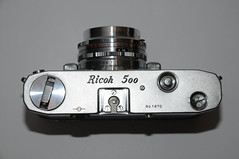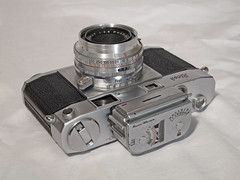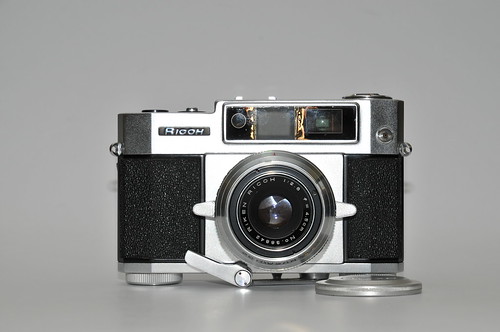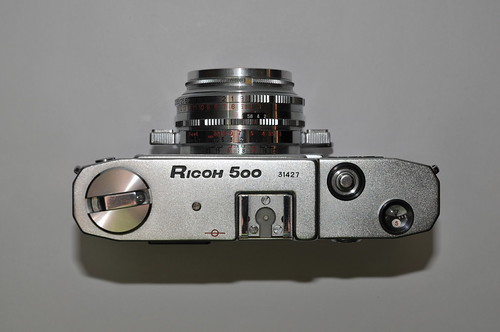Difference between revisions of "Ricoh 500"
m |
Hanskerensky (talk | contribs) m (Repaired Link URL) |
||
| Line 20: | Line 20: | ||
| − | The '''first type''', from 1957, is based on the [[Ricoh 35S]]. It has a dropped section at the each end of the top housing. At the left-hand end, the rewind knob is taller than on other versions of the camera. It doesn't have a film-type reminder, which other versions do (on the bottom). It has a [[Seikosha-MX]] shutter, with speeds 1 - 1/500 second, plus 'B', and a coated, five-element Riken Ricoh 45 mm f/2.8 lens made by [[Tomioka]].<ref>[http://www.ricoh.co.jp/ | + | The '''first type''', from 1957, is based on the [[Ricoh 35S]]. It has a dropped section at the each end of the top housing. At the left-hand end, the rewind knob is taller than on other versions of the camera. It doesn't have a film-type reminder, which other versions do (on the bottom). It has a [[Seikosha-MX]] shutter, with speeds 1 - 1/500 second, plus 'B', and a coated, five-element Riken Ricoh 45 mm f/2.8 lens made by [[Tomioka]].<ref>[http://www.ricoh-imaging.co.jp/japan/products/ricoh-filmcamera/cameralist/ricoh35S.html Ricoh 35S] in the camera list at the [http://www.ricoh-imaging.co.jp/japan/index.html Japanese Ricoh website]; presumably the same lens as on the first-type Ricoh 500.</ref> |
<br style="clear:both;"/> | <br style="clear:both;"/> | ||
| Line 75: | Line 75: | ||
|} | |} | ||
| − | The '''second type''', from 1958, is the most common one. It has a flat top plate, and the rewind crank and other controls are more-or-less flush with this. It has a [[Seikosha-MXL]] shutter, with speeds 1 - 1/500 second, plus 'B'. The lens is either a five-element Ricomat 45 mm f/2.8, made by [[Tomioka]],<ref name=RJ1>[http://www.ricoh.co.jp/ | + | The '''second type''', from 1958, is the most common one. It has a flat top plate, and the rewind crank and other controls are more-or-less flush with this. It has a [[Seikosha-MXL]] shutter, with speeds 1 - 1/500 second, plus 'B'. The lens is either a five-element Ricomat 45 mm f/2.8, made by [[Tomioka]],<ref name=RJ1>[http://www.ricoh-imaging.co.jp/japan/products/ricoh-filmcamera/cameralist/ricoh500.html Ricoh 500] entry in camera list on the [http://www.ricoh-imaging.co.jp/japan/index.html Japanese Ricoh website].</ref> or a Rikenon 45 mm f/2.4, made by [[Nitto]] Optical (on the deluxe model).<ref name=RJ2>[http://www.ricoh-imaging.co.jp/japan/products/ricoh-filmcamera/cameralist/ricoh500DX.html Ricoh 500 deluxe model] (in Japanese) on the Ricoh website.</ref> The camera has dimensions 140mm x 83mm x 67mm and weighs 670 g.<ref name=RJ1></ref> |
The Japanese Ricoh website shows an all-black example of the camera.<ref name=RJ1></ref> | The Japanese Ricoh website shows an all-black example of the camera.<ref name=RJ1></ref> | ||
Revision as of 05:20, 17 October 2017

|
| Ricoh 500, first type with Seikosha MX shutter. image by David Broglin (Image rights) |
The Ricoh 500 is a 35 mm rangefinder camera with fixed lens made in Japan by Ricoh from 1957. Four different main types were marketed between then and 1960.
All models have some features in common :
- The Triggermatic winding system; a folding trigger advance lever mounted on the bottom of the camera, operated with fingers of the left hand.
- A detachable back (i.e. not hinged: the back and base, including the winding mechanism, come off for loading).
- A coupled rangefinder, combined with the viewfinder.
- Light Value system for setting the exposure (the Ricoh 500 was the first camera in Japan to adopt the LV system); an external selenium light meter, fitting in the accessory shoe, was available (it is not coupled to the camera).
- Synchronisation for flash by a hot shoe, in addition to a PC socket.
The first type, from 1957, is based on the Ricoh 35S. It has a dropped section at the each end of the top housing. At the left-hand end, the rewind knob is taller than on other versions of the camera. It doesn't have a film-type reminder, which other versions do (on the bottom). It has a Seikosha-MX shutter, with speeds 1 - 1/500 second, plus 'B', and a coated, five-element Riken Ricoh 45 mm f/2.8 lens made by Tomioka.[1]
|
|
|
| ||||
Images by vincentnip (Image rights) | |||||
The second type, from 1958, is the most common one. It has a flat top plate, and the rewind crank and other controls are more-or-less flush with this. It has a Seikosha-MXL shutter, with speeds 1 - 1/500 second, plus 'B'. The lens is either a five-element Ricomat 45 mm f/2.8, made by Tomioka,[2] or a Rikenon 45 mm f/2.4, made by Nitto Optical (on the deluxe model).[3] The camera has dimensions 140mm x 83mm x 67mm and weighs 670 g.[2]
The Japanese Ricoh website shows an all-black example of the camera.[2]
The third type is very similar, but has the Seikosha-SLV shutter, again with speeds 1 - 1/500 second, plus 'B', but now with a self timer. The lens is the same.
The fourth type has a Riken Ricoh (not Ricomat) 45 mm f/2.8, and again a Seikosha SLV shutter. The top housing has been restyled, to accomodate a larger viewfinder, with a bright-line frame. This camera, but with an f/1.9 lens, was sold as the Ricoh Jet.
|
| ||||

|
| Ricoh 500's Triggermatic Action on the wall of an old camera store in Springfield, MA. image by Mike Zeis (Image rights) |
Notes
- ↑ Ricoh 35S in the camera list at the Japanese Ricoh website; presumably the same lens as on the first-type Ricoh 500.
- ↑ 2.0 2.1 2.2 Ricoh 500 entry in camera list on the Japanese Ricoh website.
- ↑ Ricoh 500 deluxe model (in Japanese) on the Ricoh website.
Links
- User's manuals at Mike Butkus' Orphan Cameras:
- Ricoh 500 cameras at Sylvain Halgand's Collection d'Appareils (text in French):
- First type
- Second type
- Third type (with Seikosha SLV shutter)
- Fourth type (with brightline viewfinder)
- Ricoh 500 (first type) at Karen Nakamura's Photoethnography.com.






